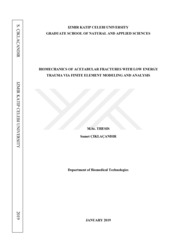Biomechanics of acetabular fractures with low energy trauma via finite element modeling and analysis Düşük enerji travmalı acetabular kırıklarının sonlu elemanlar modeli ve analizi
-
Eser Sahibi
SAMET ÇIKLAÇANDIR
- Tez Danışmanı ŞENAY MİHÇİN
-
Tür
Yüksek Lisans
- Yayın Tarihi 2019
-
Yayıncı
Graduate School of Natural and Applied Sciences
- Tek Biçim Adres https://hdl.handle.net/11469/2535
-
Konu Başlıkları
Fen bilimleri
Science
Orthopaedics
Ortopedi
Acetabular fractures
Asetabulum kırıkları
The skeletal system undertakes many tasks such as the movement of the body, mineral storage, and protection of soft tissues. Damage to this structure affects human life negatively. Fractures that occur in the human body is damage to mainly to the bone structure and associated surrounding tissues. Therefore, it is necessary to understand how the fractures are formed and the fracture mechanism. Furthermore, the mechanism of fracture is complicated and worthy of investigation. However, the examination of the bone is difficult because it is a structure covered with tissues like veins and muscles. It is not possible to perform mechanical tests of the bones over a living body. On the other hand, these experiments might be carried out on cadavers with permits received. Finding the cadaver and obtaining the necessary permissions is a very demanding task due to ethical regulations.As a more practical solution, biomechanical models have been alternative due to the advantages in computer technologies. Computer built models are utilized for simulating the effects over biomechanical mechanism in silico. The validations and verifications are performed to compare the results with the experimental test results. To perform computational analyzes, first of all, the 3D image of the region of interest is required. With the development of technology, radiological imaging methods have been developed and imaging of the bone without any surgery has been provided. Devices such as Computed Tomography (CT), Magnetic Resonance Imaging (MRI) offer the possibility to view morphology of the human without any operation. These devices provide much useful information as well as disease diagnosis. With the help of the devices, the material properties of the human bone could be determined for a realistic model to mimic the behaviour of the human body in a computer environment.ÖZETİskelet sistemi vücudun hareketi, mineral deposu, yumuşak dokuların korunması gibi pek çok görevini üstlenmiştir. Bu yapının hasar görmesi insan hayatını olumsuz etkilemektedir. İnsan vücudunda meydana gelen kırıklar, temel olarak kemik yapısına ve etrafındaki dokulara zarar verir. Bu nedenle kırıkların nasıl oluştuğunu ve kırık mekanizmasını anlamak gerekir. Ayrıca kırık mekaniği karmaşıktır ve araştırmaya değerdir. Fakat kemiğin etrafı damar ve kaslar ile örtülü olduğu için incelemek zordur. İnsan hayatta iken kemiklerin mekanik testlerini üzerinde gerçekleştirmek mümkün değildir. Diğer yandan bu deneyler ancak kadavra üzerinde, alınan izinler ile gerçekleştirilebilir. Kadavrayı bulmak ve gerekli etik izinleri almak oldukça zahmetli bir iştir.Pratik bir çözüm olarak biyomekanik modeller, bilgisayar teknolojilerinin avantajları nedeniyle altenatif olmuşlardır. Bilgisayar modellerinde simülasyonlardan faydalanılmıştır. Validasyon, model sonuçlarını deneysel test sonuçları ile kıyaslanarak yapılır. Analizleri gerçekleştirmek için öncelikle ilgi alanının 3D görüntüsü gereklidir. Teknolojinin gelişmesiyle beraber radyolojik görüntüleme yöntemleri gelişmiş ve kemiğin herhangi bir operasyon olmadan görüntülenmesi sağlanmıştır. CT, MR gibi cihazlar, herhangi bir işlem olmaksızın insanın morfolojisini görüntüleme olanağı sunar. Bu cihazlar hastalık teşhisinin yanı sıra birçok yararlı bilgi sağlar. Günümüz teknolojisinin görüntüleme teknikleri, insan kemiğinin malzeme özellikleri, insan vücudunun bilgisayar ortamındaki davranışını taklit edecek şekilde modelin gerçekliğini artırmak için kullanılabilir.
-
Koleksiyonlar
ENSTİTÜLER
FEN BİLİMLERİ ENSTİTÜSÜ

 Tam Metin
Tam Metin

